As a property owner, you may be on the lookout for some suitable retaining wall DIY projects.
Building your retaining wall can be a challenging and rewarding experience, but it’s important to be aware of the common challenges people face when undertaking such a project.
In this article, we will explore a few of the most popular retaining wall DIY projects, as well as the pros and cons of DIY retaining walls.
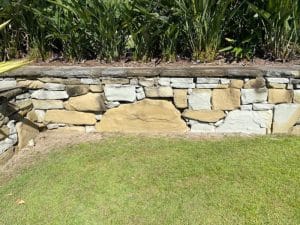 We will also take a look at when you should leave the job to the professionals, and what council requirements need to be met before starting any DIY retaining wall project.
We will also take a look at when you should leave the job to the professionals, and what council requirements need to be met before starting any DIY retaining wall project.
Finally, we will provide some tips on retaining wall DIY maintenance.
So, if you’re considering taking on a retaining wall DIY project, read on – you may just find the information you need.
Or if it isn’t here you will find more info on our DIY Retaining Walls page.
The Best Retaining Wall DIY Projects for the Property Owner
Building your own retaining wall can add value and functionality to your home, and it can be a great way to express your creative side.
However, it’s important to choose the right project and to understand the challenges that come with building a retaining wall DIY.
Here are the 7 walls that we feel can be built by a home handyman.
Dry-Stacked Concrete Blocks
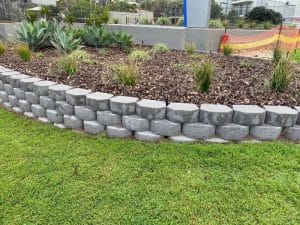 This is the most popular type of retaining wall DIY project and it’s easy to see why.
This is the most popular type of retaining wall DIY project and it’s easy to see why.
Dry-stacked concrete blocks are affordable, easy to construct and look great.
However, they are not as durable as other types of retaining walls, so they may not be suitable for projects that require a lot of weight-bearing capacity such as supporting a structure.
Interlocking Concrete Blocks
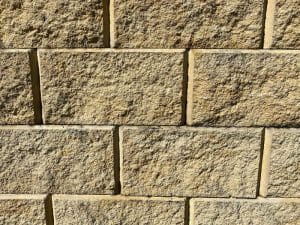 Interlocking concrete blocks are a little more expensive than dry-stacked blocks, but they are much more durable.
Interlocking concrete blocks are a little more expensive than dry-stacked blocks, but they are much more durable.
They are also easier to construct, as the blocks fit together like pieces in a puzzle.
There are different types of interlocking blocks, some are filled with gravel others are filled with reinforced concrete.
Timber Retaining Walls
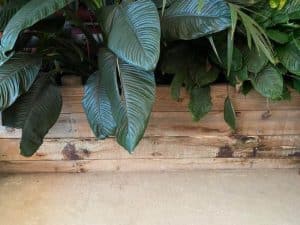 A timber retaining wall can be a great option for homeowners who are looking for a natural look.
A timber retaining wall can be a great option for homeowners who are looking for a natural look.
They are also relatively affordable, and easy to construct with basic carpentry skills.
However, timber retaining walls require regular maintenance, and they may not be suitable for projects over 1 metre high for the home handyman.
Stone Retaining Wall DIY
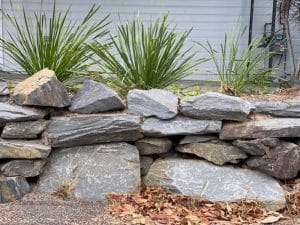 A stone retaining wall can add a touch of elegance to any property.
A stone retaining wall can add a touch of elegance to any property.
They are also relatively affordable and easy to construct and can be a great do-it-yourself project for those with some basic landscaping experience.
A stone wall less than 1 metre in height is one of the most value for money retaining walls the home handyman can build.
Some of the popular stone used in Australia is;
- sandstone
- granite
- basalt
- bush rock
- limestone
- quartzite
- slate
Concrete Sleeper Retaining Walls
Concrete sleeper retaining walls are a great option for homeowners who want a durable and long-lasting retaining wall.
They are also easy to construct and can be tailored to fit any property.
Similar to a timber wall they do require some handyman knowledge, although once the posts are concreted into place it is just a matter of fitting the sleepers into the posts.
You should avoid cutting concrete sleepers as this will expose the reinforcing steel encased in the sleeper.
Gabion Walls
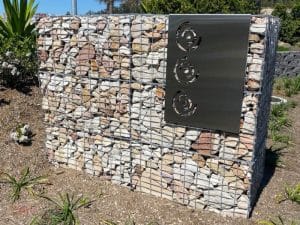 Gabion walls are made of wire mesh cages that are filled with rocks or stones. They are a great option for homeowners who want a natural look, and they are also very durable.
Gabion walls are made of wire mesh cages that are filled with rocks or stones. They are a great option for homeowners who want a natural look, and they are also very durable.
One of the advantages of gabion walls is that they can be adapted to fit any property size or shape. Gabion walls are easy to build, it’s a matter of filling the cages with stone and tying them together.
Concrete footings are not required with Gabions and drainage is not an issue.
Landscape a Battered Bank
Some people do not realise that you don’t have to have a retaining wall.
If the bank can be battered to approx 45 deg or 1 unit out for each 1 unit in height you can simply landscape the slope to stop erosion.
If the bank is supporting a loading of any kind ie a driveway or structure a wall is usually required and an engineer should be consulted.
In most cases, a wall is required to obtain the extra usable space.
8 Steps to a Successful Retaining Wall DIY Project
Building a retaining wall can be a daunting task but following these simple steps can help make the process much easier.
1. Planning and Preparation
The first step in any retaining wall DIY project is to plan and prepare.
This includes measuring the area to be retained, deciding on the type of wall, and working out the required measurements of the wall.
To find the area of the wall you simply measure the length of the wall, multiplied by the height L x H = m2. If the wall varies in height, take the measurement from the average height.
2. Decide on the Type of Wall
You will need to decide on what type of wall you require. There are a variety of walls to choose from as discussed previously.
Once you have decided, see the suppliers of the material you will be using as there are different techniques of construction for each wall type.
Suppliers will often have pre-engineered specifications for the construction of each wall.
3. Obtain Council Consent
If any part of your wall is over 1 metre in height in most states of Australia you will require council consent to build the wall. Some states are less, so you should consult your local council.
If council consent is required you may also require an engineer depending on which type of wall you have selected.
If you need consent do not start the wall until you receive notification from the council.
This is an old trick that catches homeowners out.
They have talked to the council who have said it won’t be a problem, so they excavate the area to get a head start. Then it rains…….heavily…… and council is slow in getting the permit out…….then it rains again. Stress city
4. Supply Materials
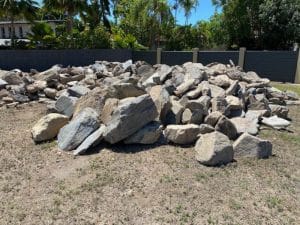 Once you have the measurements and have obtained council consent, the next step is to get the materials delivered.
Once you have the measurements and have obtained council consent, the next step is to get the materials delivered.
Do not start excavation until the materials are delivered or on standby at the supplier’s yard. You guessed it, the site gets excavated then there is a supply issue, in the meantime, it rains……..unfortunately, heavily.
When the materials are on site or sitting in the suppliers yard, then it’s time to bring in the excavator.
5. Excavation
The type of excavator you will require depends on the type of wall to be built.
If you are constructing a wall with posts as supports ie timber and concrete sleepers, you will be better off getting an excavator with a post hole borer attachment so you can cut the wall and bore the holes.
Make sure the excavator you have can also dig the type of footing required.
6. Build the Wall
This is the step where most people get stuck.
Once you have excavated to the correct depth and width, and have your footings in place it’s time to start building the wall.
Building a retaining wall is not as hard as it seems, but there are a few rules you should abide by;
- always abide by the manufacturer’s specifications and instructions
- make sure the footings are level, if they have lumps and bumps in them, so will your wall and it will all get exaggerated the higher the wall goes.
- if it needs to be level and plumb make sure it is, when it’s not level or plumb and it needs to be, problems in the build start to arise.
7. Drainage
Retaining walls can hold back a lot of water, so the correct drainage must be installed.
This can be achieved by installing a perforated pipe at the base of the wall and running it to a suitable drainage point.
The pipe should be covered in a cloth sock to stop sediment and roots from entering the pipe.
It is good practice to install drainage behind all retaining walls as it is one of the main reasons for failure, even a rock wall that has plenty of gaps for water to escape should have the water diverted to a stormwater drain.
8. Backfill the Wall
Once the wall is finished and the concrete footings have cured, it is time to backfill the wall.
This should be done in layers and compacted as you go and care should be taken to make sure free-draining stone is placed directly behind the wall.
Topsoil can be added to the top layer if vegetation is required.
Any surface drains that are required should then be added.
Pros and Cons of Retaining Wall DIY
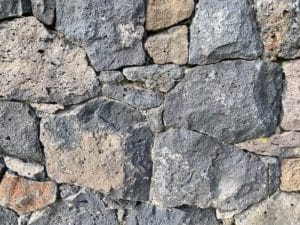 When it comes to retaining wall DIY, there are many pros and cons of whether you should do the job yourself or leave it to the professionals.
When it comes to retaining wall DIY, there are many pros and cons of whether you should do the job yourself or leave it to the professionals.
On the one hand, if you’re handy with tools and have some experience in construction, then doing the job yourself can save you a lot of money.
Retaining walls are generally not very complex, and most types can be easily constructed by a DIY enthusiast.
However, there are also a few risks involved in doing the job yourself. The main risk is that if the wall falls over and injures somebody or damages property………………. you are liable.
Ultimately, it’s up to each individual to decide whether or not they feel comfortable doing the job themselves. Just be sure to weigh up all the pros and cons before making a decision.
Advantages of Building Your Own Retaining Wall:
- Save money by doing it yourself
- Control over the finished product
- No downtime waiting for trades to start
- It can be a fun DIY project
Disadvantages of Building Your Own Retaining Wall:
- If the job isn’t completed quickly any banks that have been cut may collapse in the next rain.
- You need access to heavy machinery
- It can be dangerous if not done correctly
- You need to follow council regulations and engineers designs
- It requires a lot of work and time
- It can be expensive if you make mistakes
- You are liable if the wall fails
There are many factors to consider when deciding whether to build your retaining wall.
By weighing up the pros and cons, you can make a more informed decision on whether this is the right project for you.
When to Leave the Job to the Professionals:
There are many times when it is best to leave the job of building a retaining wall to the professionals. This includes, but is not limited to,
- The retaining wall is for a commercial property
- The retaining wall is on a boundary or street frontage
- If you don’t have general handyman knowledge
- You don’t have access to the necessary heavy machinery
- The job is too big or complicated
- If an engineer is required the wall is more than likely oversize for a handyman
- You’re not comfortable with heights
- There is a drainage issue on-site.
- If there is any electrical work to be done.
- The retaining wall is part of another structure
Council Requirements for Retaining Wall DIY Projects
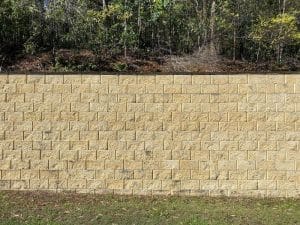 It’s important to remember that even if you are doing the job yourself, you still need to follow council regulations.
It’s important to remember that even if you are doing the job yourself, you still need to follow council regulations.
This includes getting the correct permits and following the engineer’s design.
Most councils have general requirements for retaining wall construction, which can be found on their website or by contacting their building department.
It is important to make sure that you are aware of these requirements before starting construction.
If you don’t follow the correct regulations, you may end up having to demolish your wall or face fines from the council. So it’s important to do your research before starting your project.
Most councils around Australia have conditions that apply to their state and local area that apply to, but are not limited to;
- the height of the wall, most states require consent if the wall is over 1 metre, and some are less.
- distances from the boundary vary from state to state.
- if the wall has a fence connected to it
- if the wall is part of a swimming pool fence
- restrictions on building over easements
- restrictions on street frontages
- setbacks for terraced walls
- if there are weight loadings above the wall ie structures or driveways
For regulations in your state, our area pages have more information and links to your local council. Just go to a page that is near your area.
DIY Maintenance
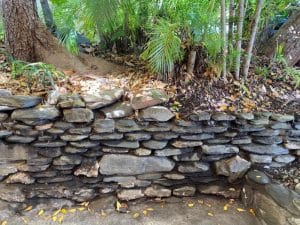 All types of retaining walls need some form of maintenance to keep them looking their best and performing as they should.
All types of retaining walls need some form of maintenance to keep them looking their best and performing as they should.
This can include anything from removing graffiti and weeds to cleaning and resealing concrete blocks.
It’s important to keep on top of any maintenance tasks, as they can become quite difficult (and expensive) to do if they’re left too long.
Some of the most common retaining wall DIY tasks include:
- Weed removal
- Keeping drainage holes unblocked
- Cleaning the wall
- Re-sealing concrete blocks
- Re-painting previously painted components
- Replacing any damaged or missing components
- Fixing cracks in the wall
- Removing tree roots from behind the wall
If you’re not comfortable doing these tasks yourself, it’s always best to get a professional in to do the job.
You can find retaining wall specialists on the area page suited to you on this site. Alternatively you will find good suppliers in your area on this page as well.
You can also find more retaining wall DIY info on our DIY page









